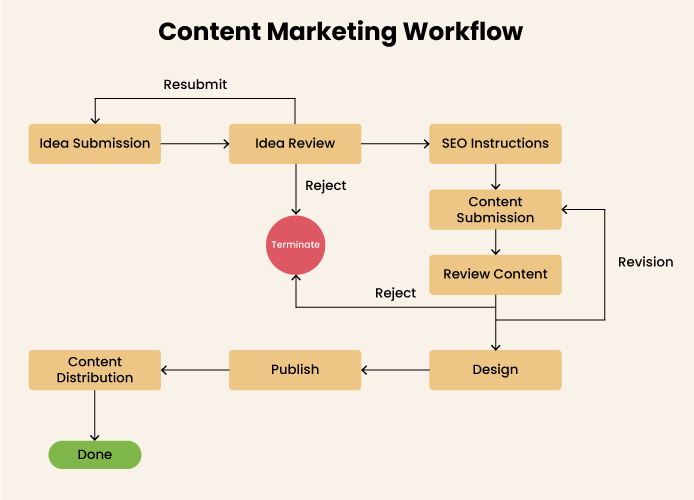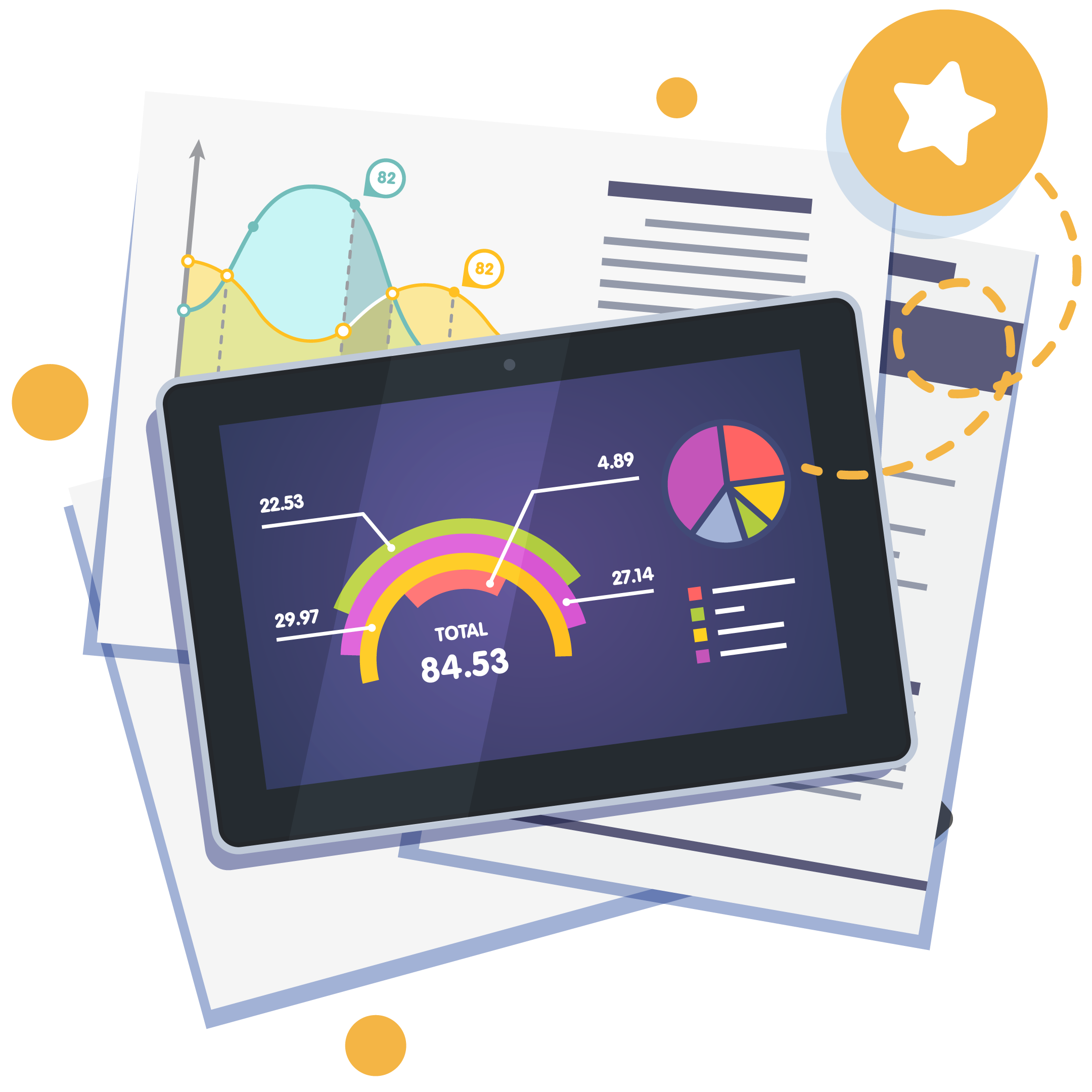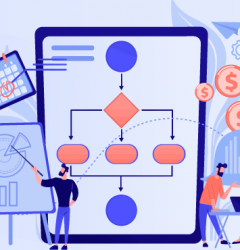
Workflow automation follows a significant sequence carried out by workflow mapping as well as workflow visualization, being a major concern. Workflow mapping exhibits a deep connection with workflow visualization as it offers a visual representation of the sequence of steps, tasks, or actions performed to get the desired outcome. The purpose is to perform the initial analysis of individual business processes sequentially through mapping. This implies every concept possesses some inbound tools or features to implement it.
Let us try to understand this in simple terms:
Workflow mapping is like developing a recipe of food with exact ingredients and their measurements before preparing it. If you only rely on the guidance of your ancestors without having an exact measure of the ingredients to pour, more chances are that you will spoil your food with anything less or anything more. Hence, it is necessary to have a physical recipe guide before preparing food rather than making guesses and regrets at the end.
An ideal recipe will offer you a step-by-step procedure for preparing food.
In the same manner, workflow process mapping will give you an exact sequential procedure that visualizes every step of the business process to find out its ups and downs. As a result, it will make your workflow efficient.
What is Workflow Mapping?
Workflow mapping is a general methodology to construct a complete process or workflow through various symbols to represent process actions and steps. Visually designing the sequence of the process enables team members to split the sophisticated process into pictorial diagrams that are easy to understand, hence making it an influential approach.
However, Giles Johnston, Co-Founder and Charted Engineer of Fraction ERP describe workflow process mapping as:
“Simply understandable steps in the process. Visualizing the steps of a process in any workflow enables you to recognize the sequence and logic of the activities and also enables every team member to reach the same page for process reviews.”
What is the purpose of Workflow Process Mapping?
If you can identify bugs in the logic, then you get the opportunity to improve it. Likewise, if you can see all the steps of your workflow, you get that chance to figure out unnecessary steps, replicated steps, and inefficiencies, thus effectively automating your business process. Hence, to realize the exact value using a business process mapping tool that allows you to improve your workflows.
Process mapping helps knowledge workers to understand crucial activities and the problems that may arise in achieving their goals. It is one of the essential ways to upgrade workflows in business. Workflow process mapping gives a clear visualization of the start and end points of the workflow, the resources required to finish the workflow, and an ideal outcome.
Mapping does not rely on presumptions, rather, it tells how people actually work.
For instance, a team leader thinks that the process may take two to three steps to complete. However, while mapping thoroughly, workflow delivers approximately 15 to 20 steps in its process.
Before writing any business process, maps, and diagrams, if you create a process map, you extract the real value out of it. Hence, the workflow map can subsequently be used as a supporting document for standard operating procedures (SOPs). Additionally, you can automate your current workflow with an ideal or proposed approach.
Also Read: Effective ROI Results with No-Code Business Workflow Automation
How does Workflow Process Mapping enhance efficiency?
Our cognition gives better perspectives which are 60,000 times faster than text. Thus the clear flowcharts that outline what must be done, where it must begin and stop, who must do what, and when it must be completed provide remarkable outcomes. Hence, it shows you a transparent version of your tasks to be done.
Also Read: Visual Workflow Builder: Simplifying Process Automation
Top four symbols for Workflow Mapping
1. Rectangle
Imagine a rectangle as a step in your process. It represents a specific task or action that needs to be done. For example, in a bakery, one rectangle might represent “mixing ingredients.”
2. Arrow
Arrows show the flow of your process. Think of them as directions. They connect the rectangles and indicate the order in which tasks are done. In our bakery, an arrow might show that after “mixing ingredients,” the next step is “baking.”
3. Diamond (Decision Point)
Diamonds are like decision points in your process. They’re where you make choices. For instance, in a shipping workflow, a diamond might ask, “Is the package fragile?” If yes, it goes one way; if no, it goes another.
4. Oval (Start/End)
Ovals mark the beginning and end of your workflow. They’re like the “start” and “finish” signs in a race. In our bakery example, the oval at the beginning would say “Start Baking Process,” and at the end, it would say “Finished Baking.”

Workflow Mapping Process: An efficient Roadmap for your Destination
The workflow mapping develops an efficient roadmap for business process automation. It gives a better vision to the users seeking how a process actually operates in different ways. Also, it generalizes your understanding to choose the shorter and most efficient path. Here are a few examples of how process mapping makes your daily operations more efficient:
1. Pretending for a Graphical Business
Mapping your business process in visual representations can build a more comprehensive view of your process. Everyone who is involved in the process will have a precise awareness of the needs, available tools, and final objective.
2. Rely on a practical approach, don’t just follow a theory
Explicitly mapping out your process with workflow process mapping will offer clear issues to look after, if any. However, not using the practical approach will keep you in a dilemma of thinking about which problems to tackle and whether any issues exist or not, you don’t know.
3. Enhance responsibilities
You can also make a schematic plan with names or roles for each stage using workflow process mapping. There will exist transparent responsibilities for every worker and hence no one can blame others when things clash or go wrong.
4. Invent alternative paths
Workflow process mapping also allows you to choose the optimal path for performing your process. If a shorter path gives more efficient outcomes than a larger one, you can opt for a shorter path. Else go for the longer one.
It also offers a reliable approach to performing your tasks. Other than this, the workflow mapping process also helps you in training new joiners with the existing processes, replicating procedures, enhancing operations, and adhering to legal requirements.
Also Read: What is Process Mining? All You Need to Know
What is Workflow Process Mapping Technique?
Various business process mapping techniques are available. Although workers most often use the terms workflow mapping and workflow diagrams simultaneously, both terms represent similar meanings and generate the same outputs.
Hence to develop our process mapping, let us go through workflow process mapping templates. Some of the mapping techniques include:
- Fundamental Flowchart
- Workflow Diagram
- High-level Mapping
- Swimlane Mapping
- Mapping Value Stream
- Mapping Value Chain
- Business Process Mapping
- Detailed Process Mapping
- Suppliers, Inputs, Processes, Outputs, Customers (SIPOC) Diagram
Also Read: What is a Business Process? 7 Practical Examples
Picking up the Best Workflow Map
All workflow maps show the various steps in a process, but different objectives are better served by different layouts. If you are in doubt while performing, just sketch it informally to get efficient results.
However, you can convert your sketches into a more official diagram if you need to record a process for documentation. A pen and paper will play enough until you require a formal business process map in BPMN (business process mapping notation).
Nevertheless, the specified chart will illustrate how some maps are more effective for particular objectives.
Real-Time Business Process Mapping Example
Workflow mapping tools can be implemented in varied fields depending on the requirements. The mapping might be simple or complex, shorter or longer as per its better efficiency. It also involves fewer details like who has the accountability for every step and documentation of how to finish each step. Let us look forward to some best practices.
1. Workflow Mapping for Healthcare Intake
The diagram below gives a visual representation of how healthcare staff host and give better services to their patients. Required patients also get labs and pharmacy services. Colors represent different stages of the workflow mapping healthcare that include intake of the patient, examination, and lab work.
2. Documentation Workflow Mapping for Content Writers
The documentation workflow is a general diagram. It employs beginning and ending points, actions, choice points, and linkages. Simple procedures and subprocesses are frequently documented in basic workflows. The below diagram shows that straightforward workflow mapping is often useful.

The above examples are giving a representation of the visual workflow to make it efficient and productive. Hence, better to draw if you are in doubt while performing any process.

Also Read: 10 Key Business Processes you can Accelerate with Document Generation Software
Map your Workflow and Make it Easy
As we are visual creatures, performing our processes using process mapping software makes our tasks more efficient and easy to accomplish. It gives you a visually engaging approach to make the complex steps of the tasks easier. You can quickly identify bugs at every step and can effectively solve them before the completion of the process. This saves time and makes workflow automation more productive.
Using workflow mapping in real-life applications can be high-yielding as the visual representation of any process will make the practical aspects easier to perform without the cultivation of defects.
Quixy is a reputed workflow automation server that offers its clients ten times faster automation services. Get Started Today! Empower your organization with automation and customized app development without coding.
Frequently Asked Questions(FAQs)
What is workflow mapping?
Workflow mapping software is a visual representation of a process that outlines each step, decision point, and action in a clear, easy-to-follow diagram. It helps understand, analyze, and optimize processes.
What are the 4 key steps of the mapping process?
Identify Process: Define the specific workflow or process you want to map.
Document Steps: List and detail each step and decision in the process.
Create a Diagram: Use flowchart symbols to create a visual representation of the workflow.
Review and Refine: Analyze the map for improvements and optimize the process.
What are the 3 basic components of workflow?
Tasks/Actions: Individual steps or actions within the process.
Decisions: Points where the process can take different paths based on conditions.
Connectors/Arrows: Lines that show the flow and sequence of tasks and decisions.
How do I create a map in the workflow?
Identify the Process: Choose the process you want to map.
List Steps: Document each step in the process.
Use Flowchart Symbols: Create a visual map using symbols like rectangles for tasks, diamonds for decisions, and arrows to connect them.
Label and Connect: Label each step and decision, and use arrows to show the flow.
Review and Optimize: Review the map for clarity and efficiency, making improvements as needed.
What is the Workflow Process?
A workflow process is a series of tasks or activities that need to be completed in a specific order to achieve a particular goal. It often involves multiple participants and can be visualized through workflow mapping.
Subscribe
Login
Please login to comment
0 Comments
Oldest















